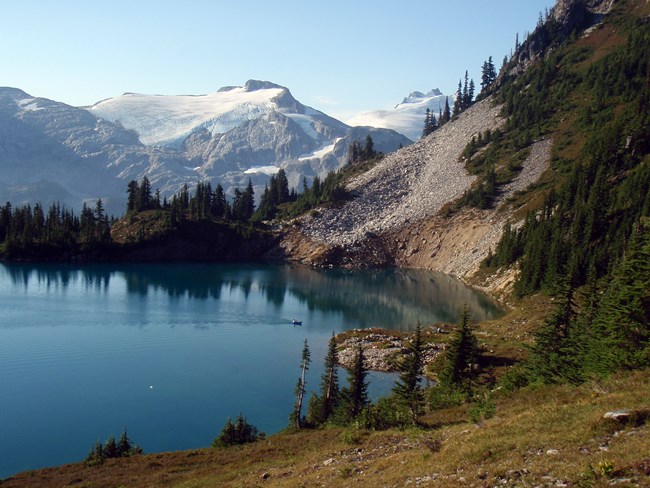
NPS Photo
Importance & Issues
Mountain lakes and ponds are keystone features of the subalpine environment in North Coast and Cascade Network parks; approximately 1,600 lakes and ponds are dotted over 1.8 million acres of park lands. These typically small, high elevation water bodies provide vital habitat for aquatic organisms, such as amphibians and dragonflies, and are a source of food (especially insects) for many terrestrial animals, including bats and birds. Mountain lakes are also prized destinations for hikers, anglers, and climbers.
In the North Coast and Cascades Network, mountain lakes are the headwaters of streams and rivers inhabited by federally threatened species, including steelhead (Oncorhynchus mykiss), Chinook salmon (Oncorhynchus tshawytscha) and bull trout (Salvelinus confluentus). These systems also provide important habitat for Washington State species of management concern, such as tailed frog (Ascaphus truei), western toad (Anaxyrus boreas), Cascades frog (Rana cascadae), and Fender’s soliperlan stonefly (Soliperla fenderi).
Mountain lakes and ponds are important indicators of watershed condition and may provide the most efficient early detection of some types of pollutants. Primary stressors that affect North Coast and Cascades Network mountain lakes and ponds include global climate change, air pollution (metals, pesticides, nutrients, and acidification), visitor disturbances, and introduction of non-native fish species.
Monitoring Objectives
- Determine the natural variation and long term trends in selected physical, chemical, and biological water quality parameters in reference lakes and ponds.
- Determine the status and trends of amphibian assemblages in focal lakes.
- Determine long-term trends in the abundance and condition of non-native fish communities in selected reference lakes.
- Document the long term effects of visitor use on shoreline condition for reference lakes.
What We Measure
- Lake physical characteristics: temperature, clarity, volume, depth, habitat, riparian disturbance
- Water chemical characteristics: pH, specific conductance, dissolved oxygen, acid neutralizing capacity, total dissolved solids, nutrients, anions and cations
- Biological characteristics: algae, zooplankton, macroinvertebrates, amphibians, non-native fish
Monitoring Questions
- What are the status and trends of the ecological condition of small lakes and ponds in the North Coast and Cascades Network parks?
- How are climate change and air quality related impacts affecting the ecological condition of lakes and ponds?
- Is disturbance from visitor use increasing, and what are the effects on the ecological condition of lakes and ponds?
Management Applications
Monitoring the status and trends of lake attributes will aid managers in identifying minimum levels of acceptable change and provide a basis for implementing management actions.
North Cascades National Park uses monitoring information to guide management of fisheries in mountain lakes to balance the public’s desire for rewarding angling experiences while protecting the Park’s natural resources.
Reports and Documents
Source: NPS DataStore Saved Search 567. To search for additional information, visit the NPS DataStore.
Source: NPS DataStore Saved Search 3703. To search for additional information, visit the NPS DataStore.
Last updated: August 11, 2025
